Analyzing Singapore's Economic Trends: A Deep Dive into Key Indicators
VerifiedAdded on 2023/04/21
|11
|2835
|122
Report
AI Summary
This report provides an in-depth analysis of Singapore's economic performance from 2008 to 2017, examining key indicators such as real GDP, unemployment rate, and inflation. It highlights the impact of the 2008 global financial crisis on Singapore's production output, followed by a recovery and stable growth period. The report identifies different types of unemployment present in Singapore, including frictional, cyclical, and structural, and discusses government measures to address unemployment and promote productivity. Furthermore, it analyzes the causes of inflation in Singapore, attributing it to both demand-pull and cost-push factors, and outlines measures for inflation control. The analysis leverages economic statistics and trends to provide a comprehensive overview of Singapore's economic landscape during the specified period. Desklib provides more solved assignments and past papers for students.
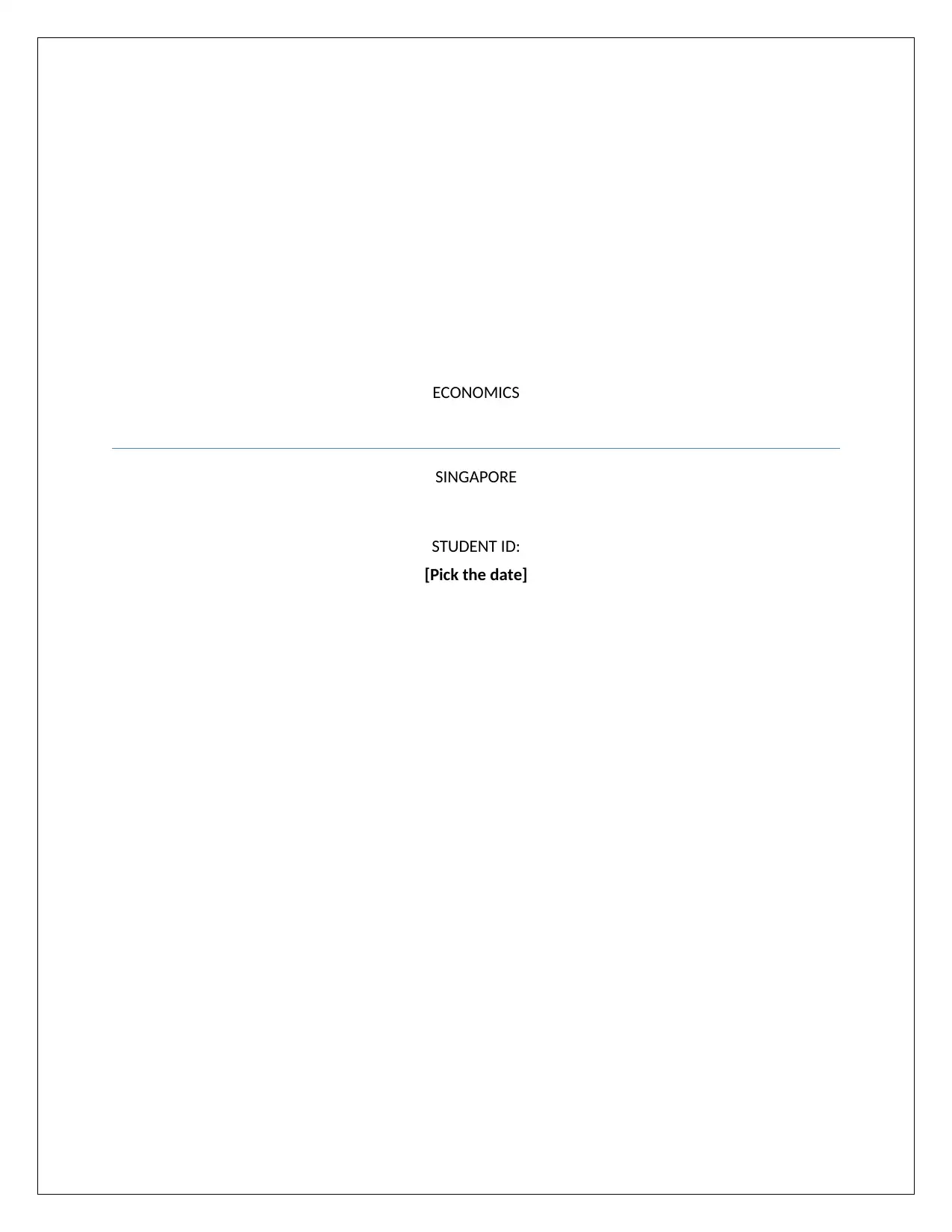
ECONOMICS
SINGAPORE
STUDENT ID:
[Pick the date]
SINGAPORE
STUDENT ID:
[Pick the date]
Paraphrase This Document
Need a fresh take? Get an instant paraphrase of this document with our AI Paraphraser

TABLE OF CONTENTS
Introduction.......................................................................................................................2
Production Output Performance - Trends..........................................................................2
Production Output Performance – Indicators and Definition.................................................4
Production Output Performance – Trends Explanation.........................................................5
Production Output Performance – Measures taken by government........................................5
Labor Market Analysis.......................................................................................................5
Unemployment – Definition and Type................................................................................6
Unemployment types in Singapore.....................................................................................6
Unemployment – Measures taken by the government..........................................................7
Price Level Analysis............................................................................................................7
Inflation – Definition and Causes.......................................................................................8
Inflation Analysis – Causes in Singapore............................................................................8
Measures for inflation control............................................................................................9
Conclusion..........................................................................................................................9
Reference..........................................................................................................................10
1
Introduction.......................................................................................................................2
Production Output Performance - Trends..........................................................................2
Production Output Performance – Indicators and Definition.................................................4
Production Output Performance – Trends Explanation.........................................................5
Production Output Performance – Measures taken by government........................................5
Labor Market Analysis.......................................................................................................5
Unemployment – Definition and Type................................................................................6
Unemployment types in Singapore.....................................................................................6
Unemployment – Measures taken by the government..........................................................7
Price Level Analysis............................................................................................................7
Inflation – Definition and Causes.......................................................................................8
Inflation Analysis – Causes in Singapore............................................................................8
Measures for inflation control............................................................................................9
Conclusion..........................................................................................................................9
Reference..........................................................................................................................10
1
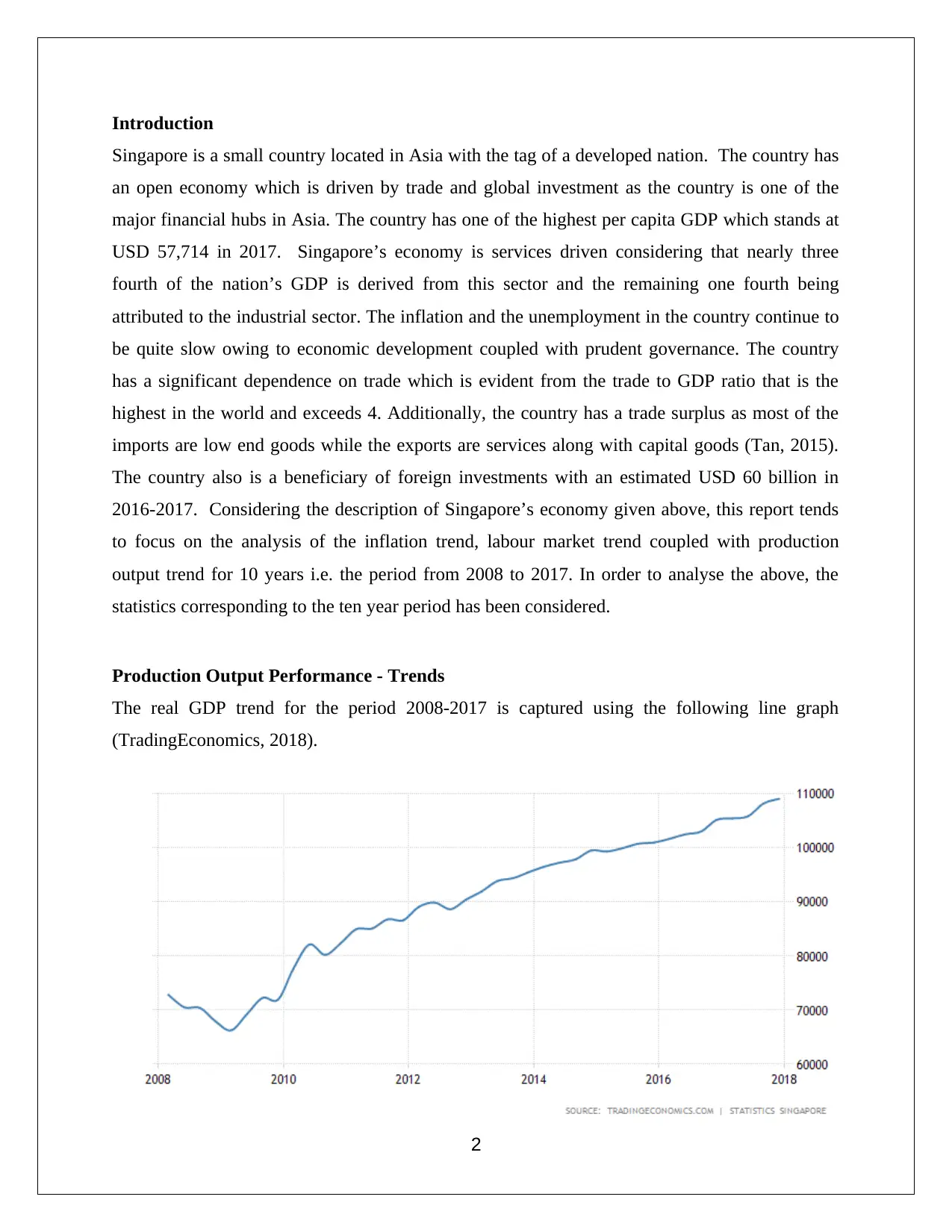
Introduction
Singapore is a small country located in Asia with the tag of a developed nation. The country has
an open economy which is driven by trade and global investment as the country is one of the
major financial hubs in Asia. The country has one of the highest per capita GDP which stands at
USD 57,714 in 2017. Singapore’s economy is services driven considering that nearly three
fourth of the nation’s GDP is derived from this sector and the remaining one fourth being
attributed to the industrial sector. The inflation and the unemployment in the country continue to
be quite slow owing to economic development coupled with prudent governance. The country
has a significant dependence on trade which is evident from the trade to GDP ratio that is the
highest in the world and exceeds 4. Additionally, the country has a trade surplus as most of the
imports are low end goods while the exports are services along with capital goods (Tan, 2015).
The country also is a beneficiary of foreign investments with an estimated USD 60 billion in
2016-2017. Considering the description of Singapore’s economy given above, this report tends
to focus on the analysis of the inflation trend, labour market trend coupled with production
output trend for 10 years i.e. the period from 2008 to 2017. In order to analyse the above, the
statistics corresponding to the ten year period has been considered.
Production Output Performance - Trends
The real GDP trend for the period 2008-2017 is captured using the following line graph
(TradingEconomics, 2018).
2
Singapore is a small country located in Asia with the tag of a developed nation. The country has
an open economy which is driven by trade and global investment as the country is one of the
major financial hubs in Asia. The country has one of the highest per capita GDP which stands at
USD 57,714 in 2017. Singapore’s economy is services driven considering that nearly three
fourth of the nation’s GDP is derived from this sector and the remaining one fourth being
attributed to the industrial sector. The inflation and the unemployment in the country continue to
be quite slow owing to economic development coupled with prudent governance. The country
has a significant dependence on trade which is evident from the trade to GDP ratio that is the
highest in the world and exceeds 4. Additionally, the country has a trade surplus as most of the
imports are low end goods while the exports are services along with capital goods (Tan, 2015).
The country also is a beneficiary of foreign investments with an estimated USD 60 billion in
2016-2017. Considering the description of Singapore’s economy given above, this report tends
to focus on the analysis of the inflation trend, labour market trend coupled with production
output trend for 10 years i.e. the period from 2008 to 2017. In order to analyse the above, the
statistics corresponding to the ten year period has been considered.
Production Output Performance - Trends
The real GDP trend for the period 2008-2017 is captured using the following line graph
(TradingEconomics, 2018).
2
⊘ This is a preview!⊘
Do you want full access?
Subscribe today to unlock all pages.

Trusted by 1+ million students worldwide
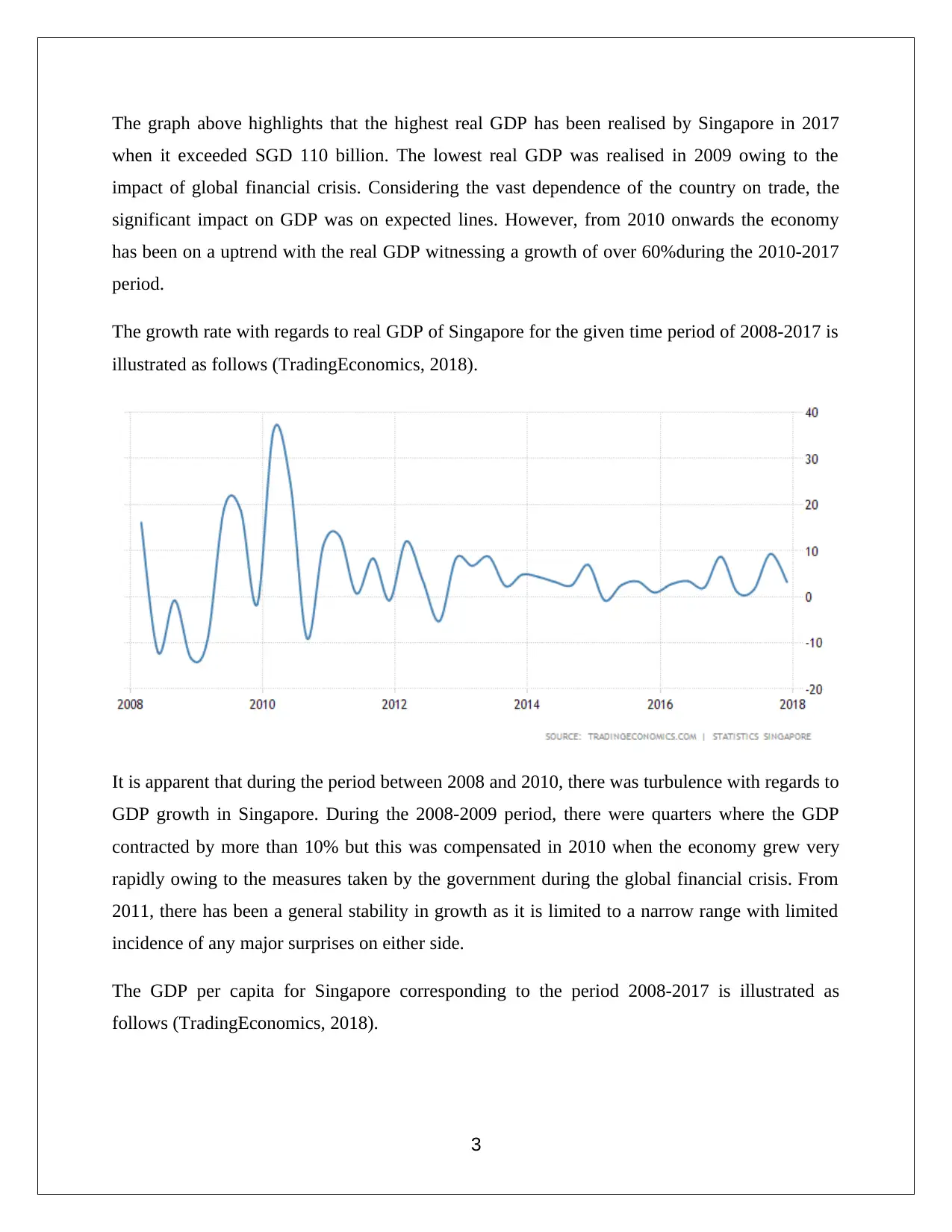
The graph above highlights that the highest real GDP has been realised by Singapore in 2017
when it exceeded SGD 110 billion. The lowest real GDP was realised in 2009 owing to the
impact of global financial crisis. Considering the vast dependence of the country on trade, the
significant impact on GDP was on expected lines. However, from 2010 onwards the economy
has been on a uptrend with the real GDP witnessing a growth of over 60%during the 2010-2017
period.
The growth rate with regards to real GDP of Singapore for the given time period of 2008-2017 is
illustrated as follows (TradingEconomics, 2018).
It is apparent that during the period between 2008 and 2010, there was turbulence with regards to
GDP growth in Singapore. During the 2008-2009 period, there were quarters where the GDP
contracted by more than 10% but this was compensated in 2010 when the economy grew very
rapidly owing to the measures taken by the government during the global financial crisis. From
2011, there has been a general stability in growth as it is limited to a narrow range with limited
incidence of any major surprises on either side.
The GDP per capita for Singapore corresponding to the period 2008-2017 is illustrated as
follows (TradingEconomics, 2018).
3
when it exceeded SGD 110 billion. The lowest real GDP was realised in 2009 owing to the
impact of global financial crisis. Considering the vast dependence of the country on trade, the
significant impact on GDP was on expected lines. However, from 2010 onwards the economy
has been on a uptrend with the real GDP witnessing a growth of over 60%during the 2010-2017
period.
The growth rate with regards to real GDP of Singapore for the given time period of 2008-2017 is
illustrated as follows (TradingEconomics, 2018).
It is apparent that during the period between 2008 and 2010, there was turbulence with regards to
GDP growth in Singapore. During the 2008-2009 period, there were quarters where the GDP
contracted by more than 10% but this was compensated in 2010 when the economy grew very
rapidly owing to the measures taken by the government during the global financial crisis. From
2011, there has been a general stability in growth as it is limited to a narrow range with limited
incidence of any major surprises on either side.
The GDP per capita for Singapore corresponding to the period 2008-2017 is illustrated as
follows (TradingEconomics, 2018).
3
Paraphrase This Document
Need a fresh take? Get an instant paraphrase of this document with our AI Paraphraser
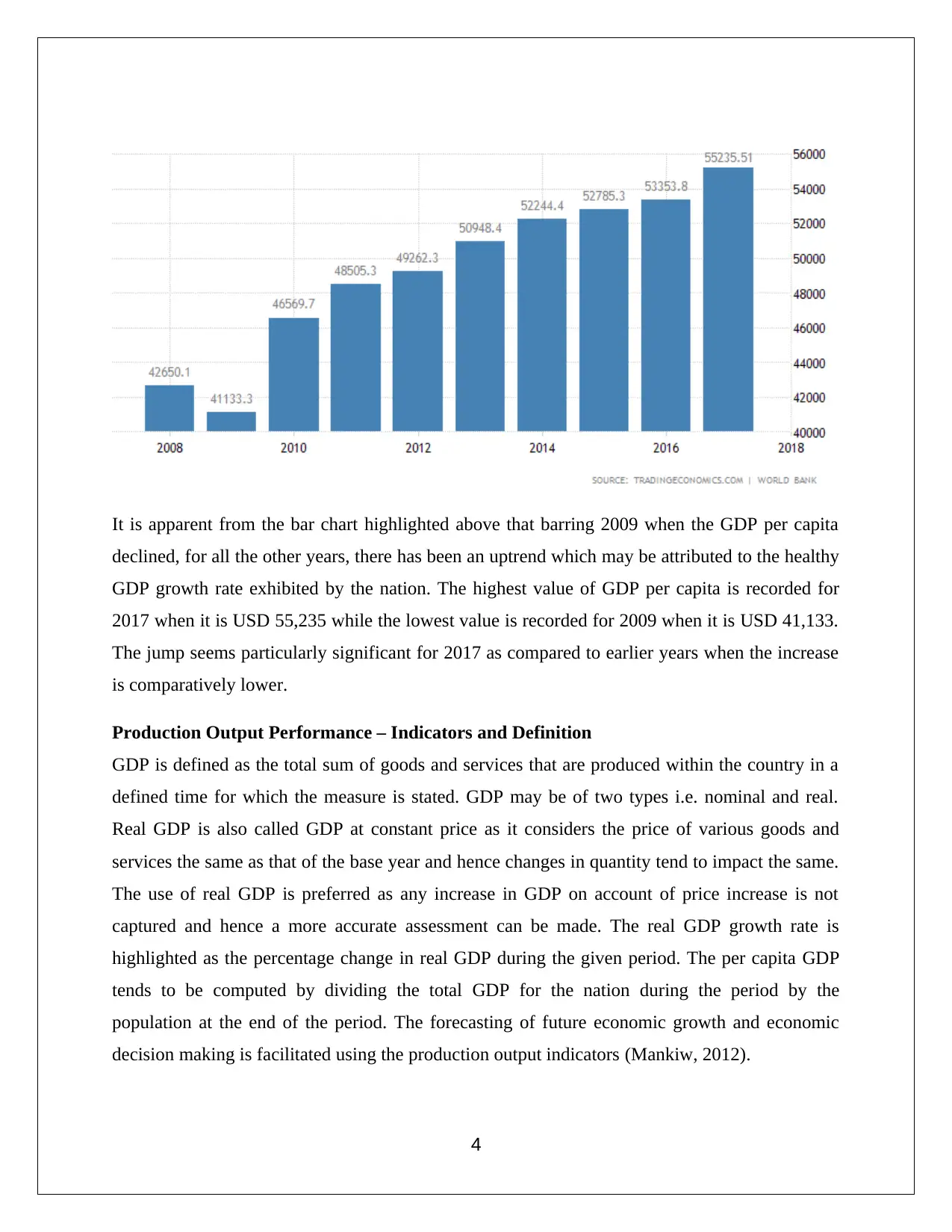
It is apparent from the bar chart highlighted above that barring 2009 when the GDP per capita
declined, for all the other years, there has been an uptrend which may be attributed to the healthy
GDP growth rate exhibited by the nation. The highest value of GDP per capita is recorded for
2017 when it is USD 55,235 while the lowest value is recorded for 2009 when it is USD 41,133.
The jump seems particularly significant for 2017 as compared to earlier years when the increase
is comparatively lower.
Production Output Performance – Indicators and Definition
GDP is defined as the total sum of goods and services that are produced within the country in a
defined time for which the measure is stated. GDP may be of two types i.e. nominal and real.
Real GDP is also called GDP at constant price as it considers the price of various goods and
services the same as that of the base year and hence changes in quantity tend to impact the same.
The use of real GDP is preferred as any increase in GDP on account of price increase is not
captured and hence a more accurate assessment can be made. The real GDP growth rate is
highlighted as the percentage change in real GDP during the given period. The per capita GDP
tends to be computed by dividing the total GDP for the nation during the period by the
population at the end of the period. The forecasting of future economic growth and economic
decision making is facilitated using the production output indicators (Mankiw, 2012).
4
declined, for all the other years, there has been an uptrend which may be attributed to the healthy
GDP growth rate exhibited by the nation. The highest value of GDP per capita is recorded for
2017 when it is USD 55,235 while the lowest value is recorded for 2009 when it is USD 41,133.
The jump seems particularly significant for 2017 as compared to earlier years when the increase
is comparatively lower.
Production Output Performance – Indicators and Definition
GDP is defined as the total sum of goods and services that are produced within the country in a
defined time for which the measure is stated. GDP may be of two types i.e. nominal and real.
Real GDP is also called GDP at constant price as it considers the price of various goods and
services the same as that of the base year and hence changes in quantity tend to impact the same.
The use of real GDP is preferred as any increase in GDP on account of price increase is not
captured and hence a more accurate assessment can be made. The real GDP growth rate is
highlighted as the percentage change in real GDP during the given period. The per capita GDP
tends to be computed by dividing the total GDP for the nation during the period by the
population at the end of the period. The forecasting of future economic growth and economic
decision making is facilitated using the production output indicators (Mankiw, 2012).
4
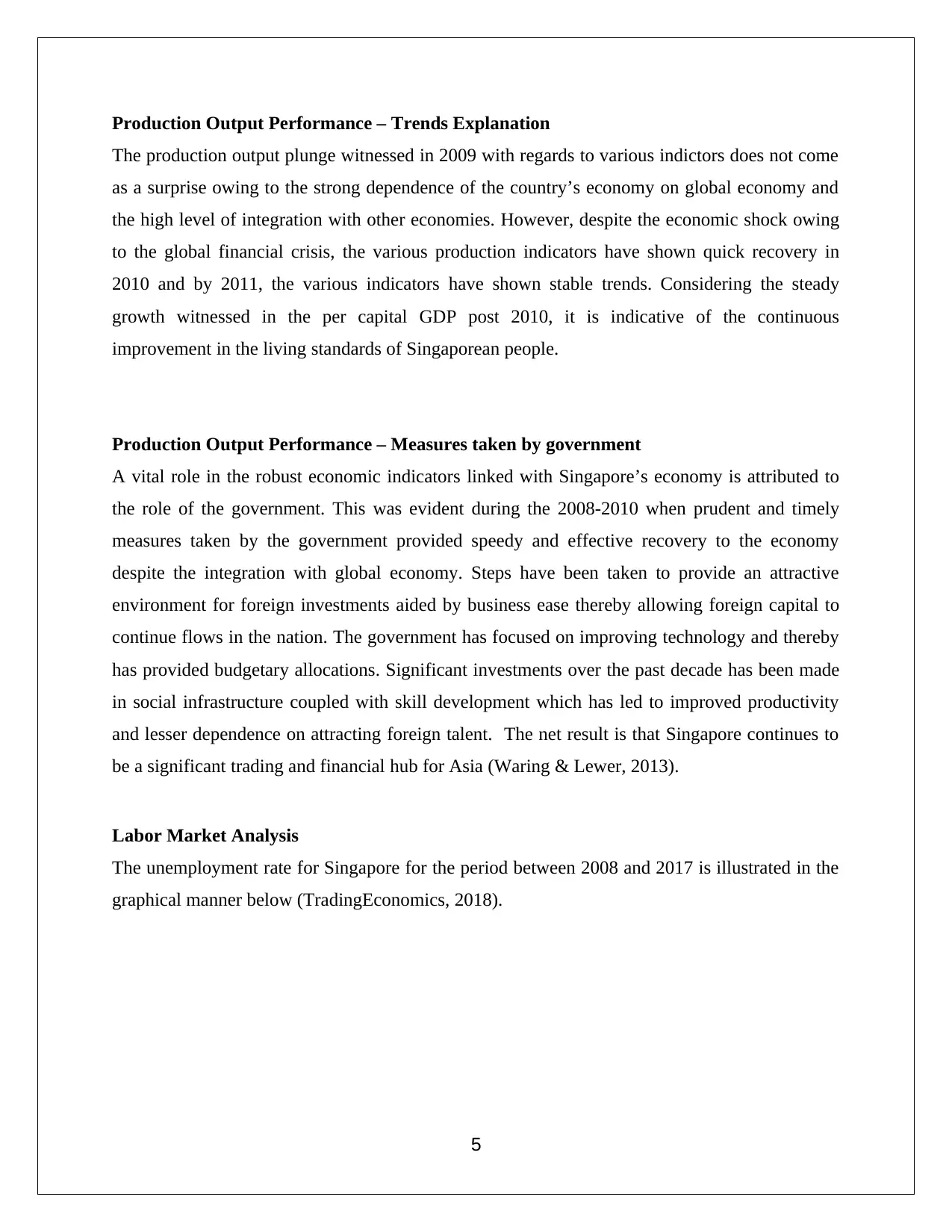
Production Output Performance – Trends Explanation
The production output plunge witnessed in 2009 with regards to various indictors does not come
as a surprise owing to the strong dependence of the country’s economy on global economy and
the high level of integration with other economies. However, despite the economic shock owing
to the global financial crisis, the various production indicators have shown quick recovery in
2010 and by 2011, the various indicators have shown stable trends. Considering the steady
growth witnessed in the per capital GDP post 2010, it is indicative of the continuous
improvement in the living standards of Singaporean people.
Production Output Performance – Measures taken by government
A vital role in the robust economic indicators linked with Singapore’s economy is attributed to
the role of the government. This was evident during the 2008-2010 when prudent and timely
measures taken by the government provided speedy and effective recovery to the economy
despite the integration with global economy. Steps have been taken to provide an attractive
environment for foreign investments aided by business ease thereby allowing foreign capital to
continue flows in the nation. The government has focused on improving technology and thereby
has provided budgetary allocations. Significant investments over the past decade has been made
in social infrastructure coupled with skill development which has led to improved productivity
and lesser dependence on attracting foreign talent. The net result is that Singapore continues to
be a significant trading and financial hub for Asia (Waring & Lewer, 2013).
Labor Market Analysis
The unemployment rate for Singapore for the period between 2008 and 2017 is illustrated in the
graphical manner below (TradingEconomics, 2018).
5
The production output plunge witnessed in 2009 with regards to various indictors does not come
as a surprise owing to the strong dependence of the country’s economy on global economy and
the high level of integration with other economies. However, despite the economic shock owing
to the global financial crisis, the various production indicators have shown quick recovery in
2010 and by 2011, the various indicators have shown stable trends. Considering the steady
growth witnessed in the per capital GDP post 2010, it is indicative of the continuous
improvement in the living standards of Singaporean people.
Production Output Performance – Measures taken by government
A vital role in the robust economic indicators linked with Singapore’s economy is attributed to
the role of the government. This was evident during the 2008-2010 when prudent and timely
measures taken by the government provided speedy and effective recovery to the economy
despite the integration with global economy. Steps have been taken to provide an attractive
environment for foreign investments aided by business ease thereby allowing foreign capital to
continue flows in the nation. The government has focused on improving technology and thereby
has provided budgetary allocations. Significant investments over the past decade has been made
in social infrastructure coupled with skill development which has led to improved productivity
and lesser dependence on attracting foreign talent. The net result is that Singapore continues to
be a significant trading and financial hub for Asia (Waring & Lewer, 2013).
Labor Market Analysis
The unemployment rate for Singapore for the period between 2008 and 2017 is illustrated in the
graphical manner below (TradingEconomics, 2018).
5
⊘ This is a preview!⊘
Do you want full access?
Subscribe today to unlock all pages.

Trusted by 1+ million students worldwide

The column chart exhibited above highlights that the peak unemployment levels for Singapore
during 2008-2017 were witnessed during 2009. During this period unemployment rate crossed
3%. However, there was a significant drop in the unemployment by more than 100 basis points
in 2010. From 2011 to the end of 2017, the unemployment rate has remained stable between
1.8% and 2.2%.
Unemployment – Definition and Type
Unemployment refers to a scenario where a person who is willing to work is not able to obtain
any employment. Considering that there may be different causes of unemployment, hence it can
be of essentially three types i.e. frictional, cyclical and structural.
Frictional unemployment is the result of the time that the individual takes to get a desired job
after resigning from the previous job. Cyclical unemployment is caused on account of lower
demand of manpower which is the result of business cycle fluctuations as the manpower demand
varies based on the stage of business cycle (Weale, Blake & Christodoulakis, 2015). Structural
unemployment tends to result when there is surplus of manpower available but they lack the
necessary skills owing to which there is shortage of skilled manpower and unemployment at the
same time (Goodwin et al., 2013).
Unemployment types in Singapore
The unemployment types that exist in Singapore are highlighted as follows.
6
during 2008-2017 were witnessed during 2009. During this period unemployment rate crossed
3%. However, there was a significant drop in the unemployment by more than 100 basis points
in 2010. From 2011 to the end of 2017, the unemployment rate has remained stable between
1.8% and 2.2%.
Unemployment – Definition and Type
Unemployment refers to a scenario where a person who is willing to work is not able to obtain
any employment. Considering that there may be different causes of unemployment, hence it can
be of essentially three types i.e. frictional, cyclical and structural.
Frictional unemployment is the result of the time that the individual takes to get a desired job
after resigning from the previous job. Cyclical unemployment is caused on account of lower
demand of manpower which is the result of business cycle fluctuations as the manpower demand
varies based on the stage of business cycle (Weale, Blake & Christodoulakis, 2015). Structural
unemployment tends to result when there is surplus of manpower available but they lack the
necessary skills owing to which there is shortage of skilled manpower and unemployment at the
same time (Goodwin et al., 2013).
Unemployment types in Singapore
The unemployment types that exist in Singapore are highlighted as follows.
6
Paraphrase This Document
Need a fresh take? Get an instant paraphrase of this document with our AI Paraphraser

Frictional unemployment is indeed present in Singapore as there are people who tend to leave
their jobs owing to lack of satisfaction or for better prospects. In certain cases, there may be
delay with regards to again getting employed and hence the person would remain unemployed
during that time interval (Pigou, 2013).
There is cyclical unemployment which is evident from the rising unemployment in 2008-2009
primarily because there was fall in the demand for goods and services because of contraction of
GDP. However, when there was recovery of economic growth from 2010 onwards, there was
improvement in this regards and resulting in lower unemployment rate (Tan, 2015).
Structure unemployment also exists in Singapore owing to the continued focus of the economy
on services and high technology industries. In such sectors, the skills required tend to be
dynamic and hence based on the progress in the sector, there is a need to upgrade the skills
accordingly to maintain relevance. Failure to upgrade the skills would result in the concerned
person having redundant skills leading to unemployment (McTaggart, Findlay & Parkin, 2012).
Unemployment – Measures taken by the government
A pivotal measure taken by the government is to provide fiscal support to measures aimed at
productivity improvement and innovation. This results in the exports being cost competitive
which is essential for continued economic development and stability (Borio, 2014). The
government also has robust social support for unemployed in the form of programs like
Workfare Income Supplement (WIS) which provides interim support to the unemployed to
search for better opportunities and upgrading their skills accordingly (Wagner, 2014). The
Singapore government realises the menace of potential increase of structural unemployment and
hence has started Skill Programme for Upgrading and Resilience (SPUR) which aims to provide
the trainees with an opportunity to build skills while earning a living (Cho & Newhouse, 2013).
Price Level Analysis
The trend in inflation over the given period from 2008 to 2017 is captured using the line graph
highlighted as follows (TradingEconomics, 2018).
7
their jobs owing to lack of satisfaction or for better prospects. In certain cases, there may be
delay with regards to again getting employed and hence the person would remain unemployed
during that time interval (Pigou, 2013).
There is cyclical unemployment which is evident from the rising unemployment in 2008-2009
primarily because there was fall in the demand for goods and services because of contraction of
GDP. However, when there was recovery of economic growth from 2010 onwards, there was
improvement in this regards and resulting in lower unemployment rate (Tan, 2015).
Structure unemployment also exists in Singapore owing to the continued focus of the economy
on services and high technology industries. In such sectors, the skills required tend to be
dynamic and hence based on the progress in the sector, there is a need to upgrade the skills
accordingly to maintain relevance. Failure to upgrade the skills would result in the concerned
person having redundant skills leading to unemployment (McTaggart, Findlay & Parkin, 2012).
Unemployment – Measures taken by the government
A pivotal measure taken by the government is to provide fiscal support to measures aimed at
productivity improvement and innovation. This results in the exports being cost competitive
which is essential for continued economic development and stability (Borio, 2014). The
government also has robust social support for unemployed in the form of programs like
Workfare Income Supplement (WIS) which provides interim support to the unemployed to
search for better opportunities and upgrading their skills accordingly (Wagner, 2014). The
Singapore government realises the menace of potential increase of structural unemployment and
hence has started Skill Programme for Upgrading and Resilience (SPUR) which aims to provide
the trainees with an opportunity to build skills while earning a living (Cho & Newhouse, 2013).
Price Level Analysis
The trend in inflation over the given period from 2008 to 2017 is captured using the line graph
highlighted as follows (TradingEconomics, 2018).
7
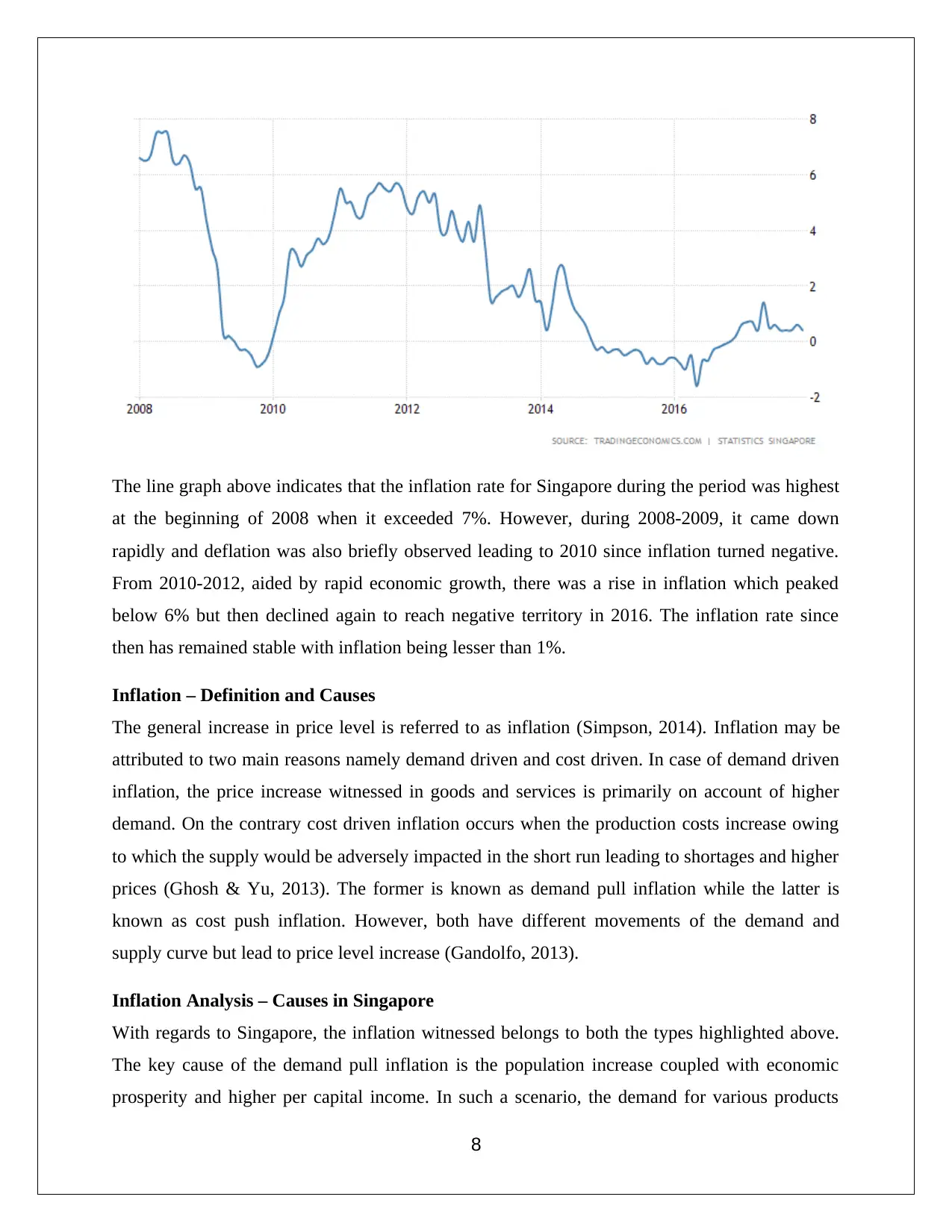
The line graph above indicates that the inflation rate for Singapore during the period was highest
at the beginning of 2008 when it exceeded 7%. However, during 2008-2009, it came down
rapidly and deflation was also briefly observed leading to 2010 since inflation turned negative.
From 2010-2012, aided by rapid economic growth, there was a rise in inflation which peaked
below 6% but then declined again to reach negative territory in 2016. The inflation rate since
then has remained stable with inflation being lesser than 1%.
Inflation – Definition and Causes
The general increase in price level is referred to as inflation (Simpson, 2014). Inflation may be
attributed to two main reasons namely demand driven and cost driven. In case of demand driven
inflation, the price increase witnessed in goods and services is primarily on account of higher
demand. On the contrary cost driven inflation occurs when the production costs increase owing
to which the supply would be adversely impacted in the short run leading to shortages and higher
prices (Ghosh & Yu, 2013). The former is known as demand pull inflation while the latter is
known as cost push inflation. However, both have different movements of the demand and
supply curve but lead to price level increase (Gandolfo, 2013).
Inflation Analysis – Causes in Singapore
With regards to Singapore, the inflation witnessed belongs to both the types highlighted above.
The key cause of the demand pull inflation is the population increase coupled with economic
prosperity and higher per capital income. In such a scenario, the demand for various products
8
at the beginning of 2008 when it exceeded 7%. However, during 2008-2009, it came down
rapidly and deflation was also briefly observed leading to 2010 since inflation turned negative.
From 2010-2012, aided by rapid economic growth, there was a rise in inflation which peaked
below 6% but then declined again to reach negative territory in 2016. The inflation rate since
then has remained stable with inflation being lesser than 1%.
Inflation – Definition and Causes
The general increase in price level is referred to as inflation (Simpson, 2014). Inflation may be
attributed to two main reasons namely demand driven and cost driven. In case of demand driven
inflation, the price increase witnessed in goods and services is primarily on account of higher
demand. On the contrary cost driven inflation occurs when the production costs increase owing
to which the supply would be adversely impacted in the short run leading to shortages and higher
prices (Ghosh & Yu, 2013). The former is known as demand pull inflation while the latter is
known as cost push inflation. However, both have different movements of the demand and
supply curve but lead to price level increase (Gandolfo, 2013).
Inflation Analysis – Causes in Singapore
With regards to Singapore, the inflation witnessed belongs to both the types highlighted above.
The key cause of the demand pull inflation is the population increase coupled with economic
prosperity and higher per capital income. In such a scenario, the demand for various products
8
⊘ This is a preview!⊘
Do you want full access?
Subscribe today to unlock all pages.

Trusted by 1+ million students worldwide
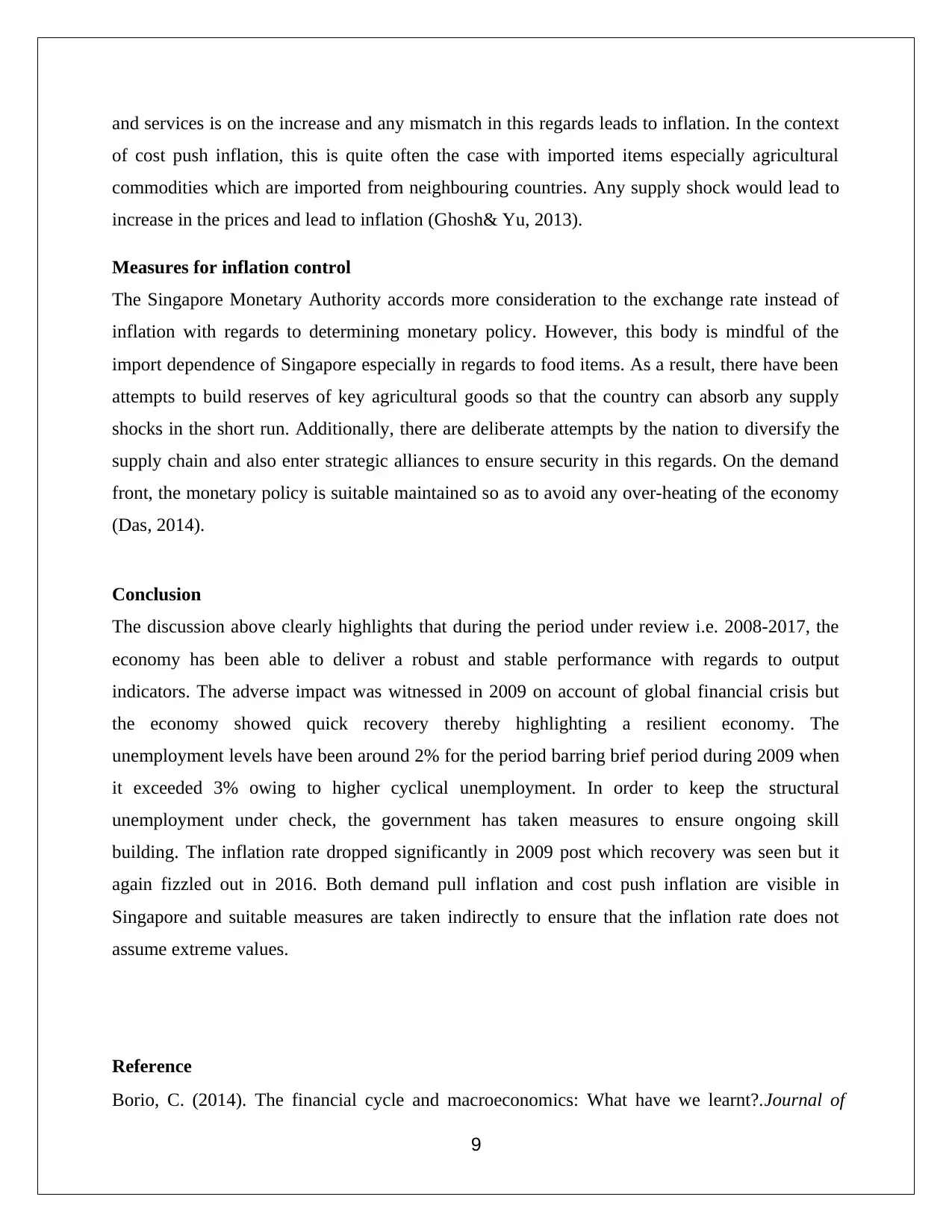
and services is on the increase and any mismatch in this regards leads to inflation. In the context
of cost push inflation, this is quite often the case with imported items especially agricultural
commodities which are imported from neighbouring countries. Any supply shock would lead to
increase in the prices and lead to inflation (Ghosh& Yu, 2013).
Measures for inflation control
The Singapore Monetary Authority accords more consideration to the exchange rate instead of
inflation with regards to determining monetary policy. However, this body is mindful of the
import dependence of Singapore especially in regards to food items. As a result, there have been
attempts to build reserves of key agricultural goods so that the country can absorb any supply
shocks in the short run. Additionally, there are deliberate attempts by the nation to diversify the
supply chain and also enter strategic alliances to ensure security in this regards. On the demand
front, the monetary policy is suitable maintained so as to avoid any over-heating of the economy
(Das, 2014).
Conclusion
The discussion above clearly highlights that during the period under review i.e. 2008-2017, the
economy has been able to deliver a robust and stable performance with regards to output
indicators. The adverse impact was witnessed in 2009 on account of global financial crisis but
the economy showed quick recovery thereby highlighting a resilient economy. The
unemployment levels have been around 2% for the period barring brief period during 2009 when
it exceeded 3% owing to higher cyclical unemployment. In order to keep the structural
unemployment under check, the government has taken measures to ensure ongoing skill
building. The inflation rate dropped significantly in 2009 post which recovery was seen but it
again fizzled out in 2016. Both demand pull inflation and cost push inflation are visible in
Singapore and suitable measures are taken indirectly to ensure that the inflation rate does not
assume extreme values.
Reference
Borio, C. (2014). The financial cycle and macroeconomics: What have we learnt?.Journal of
9
of cost push inflation, this is quite often the case with imported items especially agricultural
commodities which are imported from neighbouring countries. Any supply shock would lead to
increase in the prices and lead to inflation (Ghosh& Yu, 2013).
Measures for inflation control
The Singapore Monetary Authority accords more consideration to the exchange rate instead of
inflation with regards to determining monetary policy. However, this body is mindful of the
import dependence of Singapore especially in regards to food items. As a result, there have been
attempts to build reserves of key agricultural goods so that the country can absorb any supply
shocks in the short run. Additionally, there are deliberate attempts by the nation to diversify the
supply chain and also enter strategic alliances to ensure security in this regards. On the demand
front, the monetary policy is suitable maintained so as to avoid any over-heating of the economy
(Das, 2014).
Conclusion
The discussion above clearly highlights that during the period under review i.e. 2008-2017, the
economy has been able to deliver a robust and stable performance with regards to output
indicators. The adverse impact was witnessed in 2009 on account of global financial crisis but
the economy showed quick recovery thereby highlighting a resilient economy. The
unemployment levels have been around 2% for the period barring brief period during 2009 when
it exceeded 3% owing to higher cyclical unemployment. In order to keep the structural
unemployment under check, the government has taken measures to ensure ongoing skill
building. The inflation rate dropped significantly in 2009 post which recovery was seen but it
again fizzled out in 2016. Both demand pull inflation and cost push inflation are visible in
Singapore and suitable measures are taken indirectly to ensure that the inflation rate does not
assume extreme values.
Reference
Borio, C. (2014). The financial cycle and macroeconomics: What have we learnt?.Journal of
9
Paraphrase This Document
Need a fresh take? Get an instant paraphrase of this document with our AI Paraphraser
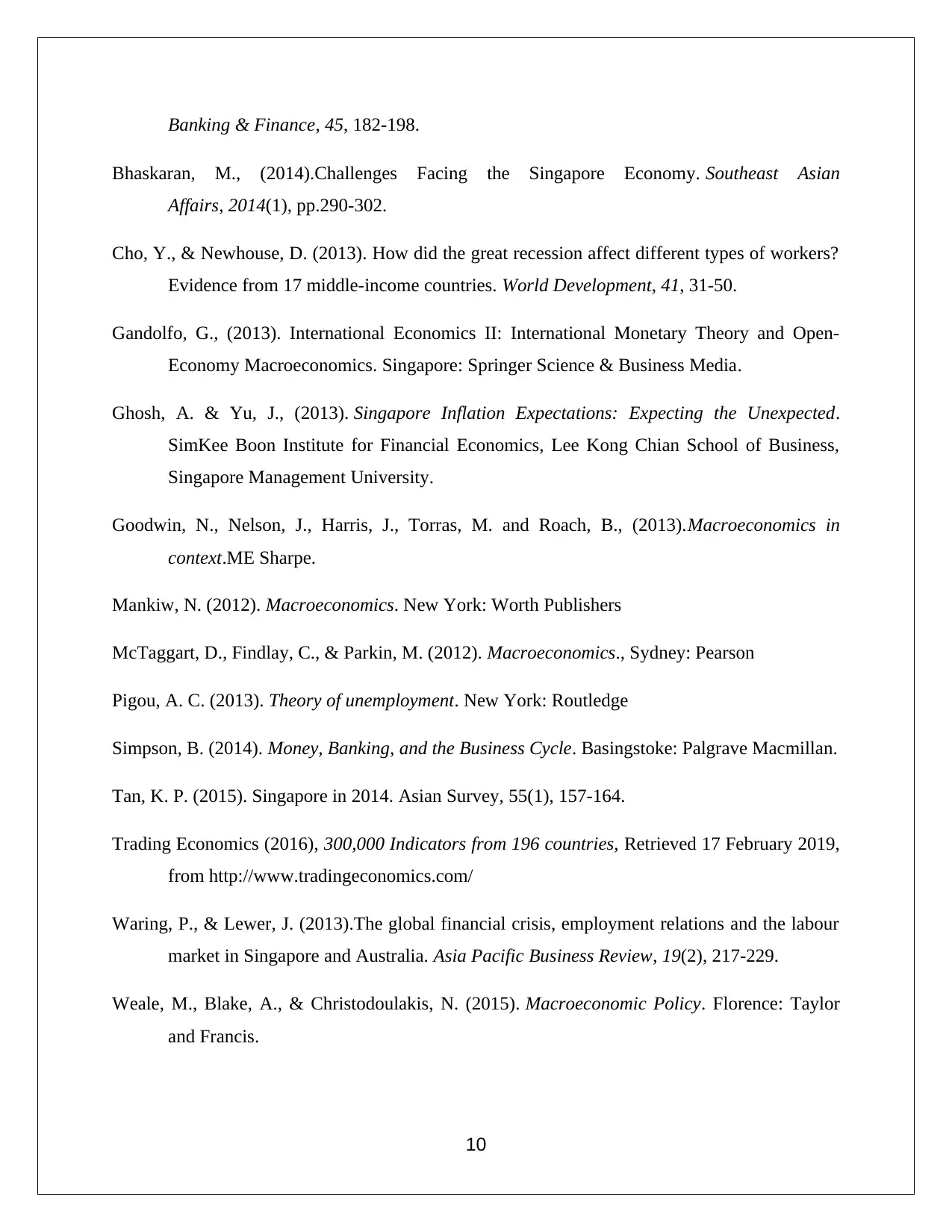
Banking & Finance, 45, 182-198.
Bhaskaran, M., (2014).Challenges Facing the Singapore Economy. Southeast Asian
Affairs, 2014(1), pp.290-302.
Cho, Y., & Newhouse, D. (2013). How did the great recession affect different types of workers?
Evidence from 17 middle-income countries. World Development, 41, 31-50.
Gandolfo, G., (2013). International Economics II: International Monetary Theory and Open-
Economy Macroeconomics. Singapore: Springer Science & Business Media.
Ghosh, A. & Yu, J., (2013). Singapore Inflation Expectations: Expecting the Unexpected.
SimKee Boon Institute for Financial Economics, Lee Kong Chian School of Business,
Singapore Management University.
Goodwin, N., Nelson, J., Harris, J., Torras, M. and Roach, B., (2013).Macroeconomics in
context.ME Sharpe.
Mankiw, N. (2012). Macroeconomics. New York: Worth Publishers
McTaggart, D., Findlay, C., & Parkin, M. (2012). Macroeconomics., Sydney: Pearson
Pigou, A. C. (2013). Theory of unemployment. New York: Routledge
Simpson, B. (2014). Money, Banking, and the Business Cycle. Basingstoke: Palgrave Macmillan.
Tan, K. P. (2015). Singapore in 2014. Asian Survey, 55(1), 157-164.
Trading Economics (2016), 300,000 Indicators from 196 countries, Retrieved 17 February 2019,
from http://www.tradingeconomics.com/
Waring, P., & Lewer, J. (2013).The global financial crisis, employment relations and the labour
market in Singapore and Australia. Asia Pacific Business Review, 19(2), 217-229.
Weale, M., Blake, A., & Christodoulakis, N. (2015). Macroeconomic Policy. Florence: Taylor
and Francis.
10
Bhaskaran, M., (2014).Challenges Facing the Singapore Economy. Southeast Asian
Affairs, 2014(1), pp.290-302.
Cho, Y., & Newhouse, D. (2013). How did the great recession affect different types of workers?
Evidence from 17 middle-income countries. World Development, 41, 31-50.
Gandolfo, G., (2013). International Economics II: International Monetary Theory and Open-
Economy Macroeconomics. Singapore: Springer Science & Business Media.
Ghosh, A. & Yu, J., (2013). Singapore Inflation Expectations: Expecting the Unexpected.
SimKee Boon Institute for Financial Economics, Lee Kong Chian School of Business,
Singapore Management University.
Goodwin, N., Nelson, J., Harris, J., Torras, M. and Roach, B., (2013).Macroeconomics in
context.ME Sharpe.
Mankiw, N. (2012). Macroeconomics. New York: Worth Publishers
McTaggart, D., Findlay, C., & Parkin, M. (2012). Macroeconomics., Sydney: Pearson
Pigou, A. C. (2013). Theory of unemployment. New York: Routledge
Simpson, B. (2014). Money, Banking, and the Business Cycle. Basingstoke: Palgrave Macmillan.
Tan, K. P. (2015). Singapore in 2014. Asian Survey, 55(1), 157-164.
Trading Economics (2016), 300,000 Indicators from 196 countries, Retrieved 17 February 2019,
from http://www.tradingeconomics.com/
Waring, P., & Lewer, J. (2013).The global financial crisis, employment relations and the labour
market in Singapore and Australia. Asia Pacific Business Review, 19(2), 217-229.
Weale, M., Blake, A., & Christodoulakis, N. (2015). Macroeconomic Policy. Florence: Taylor
and Francis.
10
1 out of 11
Related Documents
Your All-in-One AI-Powered Toolkit for Academic Success.
+13062052269
info@desklib.com
Available 24*7 on WhatsApp / Email
![[object Object]](/_next/static/media/star-bottom.7253800d.svg)
Unlock your academic potential
Copyright © 2020–2026 A2Z Services. All Rights Reserved. Developed and managed by ZUCOL.



